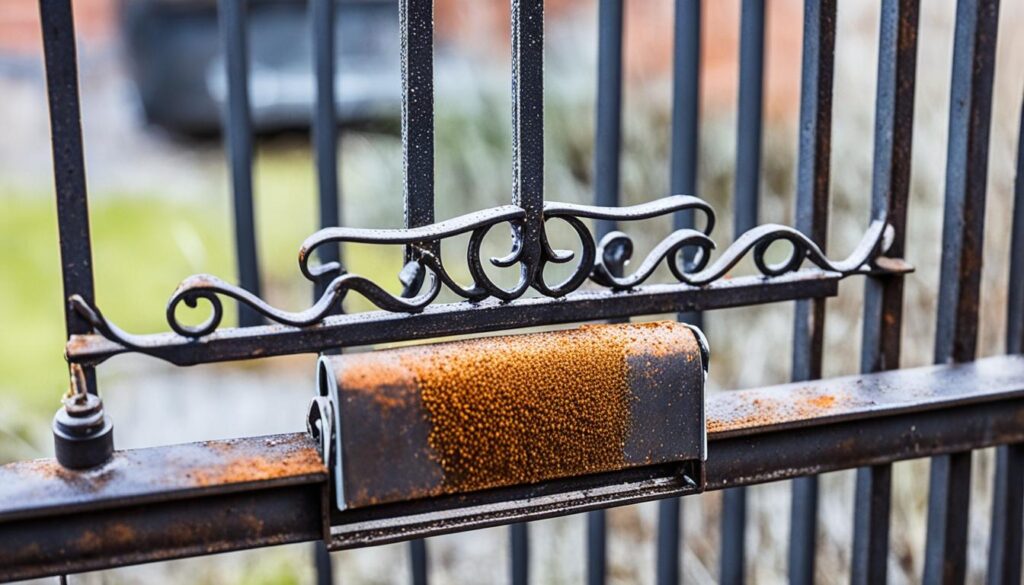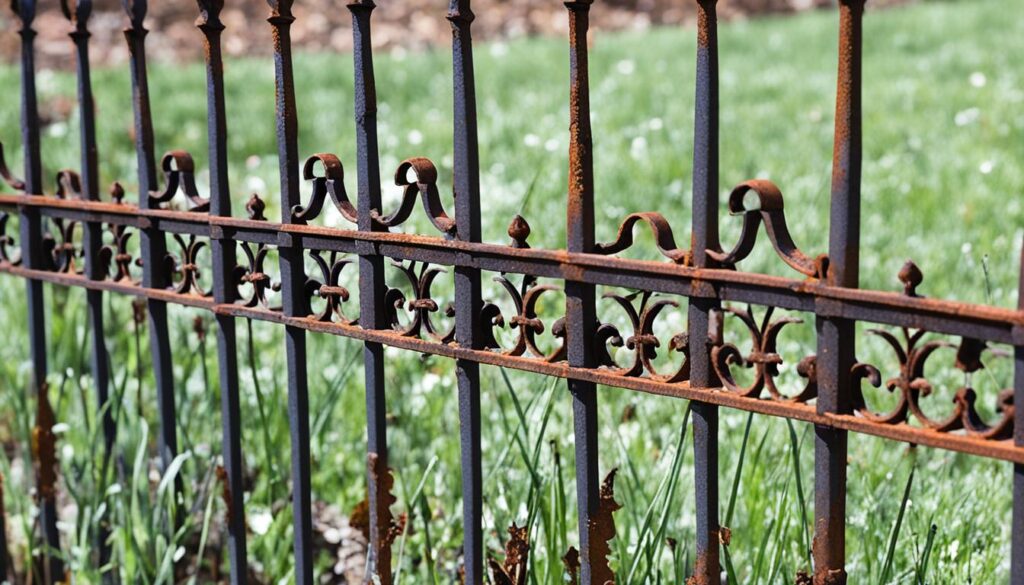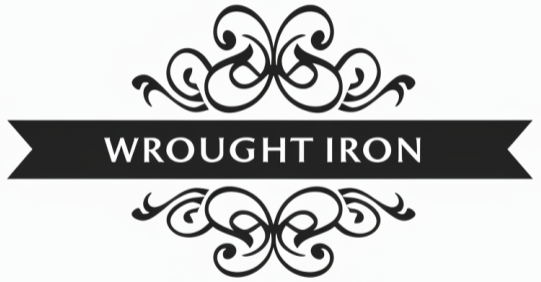
On a warm Saturday morning, you decide to relax in your backyard, enjoying the tranquility of your rustic wrought iron furniture. But, you notice the creeping presence of rust, tainting the beauty of your cherished pieces. It’s disheartening to see how quickly wrought iron can be affected by the elements, especially after a season filled with heavy moisture or harsh winter conditions.
The resilience of wrought iron makes it a popular choice for outdoor furniture, gates, and décor. But rust can mar its aesthetic attraction and structural integrity. Before you consider disposing of your tarnished wrought iron items, it’s essential to understand that rust removal doesn’t have to be an overwhelming task.
By using a combination of DIY methods and commercially available cleaners, you can breathe new life into your wrought iron, making it as good as new.
About 60% of wrought iron surfaces can be cleaned and rust removed using simple tools like wire brushes and steel wool, depending on the intricacy of the iron details1. For quick and efficient methods, power drills with special attachments are most effective in about 30% of cases, especially for intricate designs1. There’s also the option of chemicals or rust converters used in about 10% of situations to turn layers of rust back into thick layers of iron1. For more severe cases, around 25% of wrought iron surfaces may require repairs using special epoxy or polyester resin1.
Remember, maintaining the beauty and integrity of your wrought iron doesn’t just preserve your outdoor aesthetic—it preserves memories. Let’s dive into the most effective methods for removing rust from wrought iron, ensuring your cherished items endure for years to come.
Key Takeaways
- About 60% of wrought iron surfaces can be cleaned using wire brushes and steel wool1.
- Power drills with special attachments are effective in 30% of rust removal cases, especially intricate designs1.
- Chemicals and rust converters turn rust into iron in around 10% of cases1.
- Up to 25% of wrought iron surfaces may need repairs with epoxy or polyester resin due to severe rust deterioration1.
- Professionals handle 75% of wrought iron rust removal projects due to the process’s time-consuming nature1.
Introduction to Rust on Wrought Iron Furniture
Wrought iron furniture is common on patios and in outdoor areas. It can rust due to a reaction between iron, oxygen, and water. This reaction, sped up by acidic substances, creates rust and weakens the metal.
Why Wrought Iron Rusts
Moisture, air, and oxygen make wrought iron furniture rust, especially after a wet winter2. Rust is iron oxidation from the metal reacting with the environment. This makes the material weaker over time.
Things like rain and humidity make rust worse. That’s why treating iron against rust is key. Acidic things like bird droppings or dirty rain can also speed up rust. So, it’s important to remove rust stains quickly from wrought iron.
Common Problems Associated with Rust
Rust can block moving parts like joints or hinges on wrought iron furniture3. This makes the furniture hard to use and maintain. It also lowers its overall usefulness.
Rust also makes the furniture look old and worn. If not treated, rust can weaken the furniture’s structure. This might mean you need to replace it, which can be expensive3. So, learning how to remove rust and treat iron against rust is important to keep your outdoor furniture in good shape.
Preparation: What You Need Before Removing Rust
Getting ready is key to effectively removing rust from wrought iron. You need the right tools and safety gear. This makes the process easier and safer. Removing rust not only makes wrought iron look great again but also keeps it strong. This helps it last longer4.
Essential Tools and Supplies
Before starting wrought iron restoration, you should collect some important tools and materials:
- Steel wool
- Metal bristle brushes
- Cleaning cloths
- Household items like white vinegar and baking soda
- Commercial rust remover solutions
These tools are crucial for removing rust from wrought iron4. You can scrub with a wire brush or use a commercial rust remover to get rid of rust4.
Safety Precautions
Always put safety first when removing rust:
- Rubber gloves, goggles, and protective clothing are a must, especially with strong agents like oxalic acid.
- Make sure your work area is well-ventilated to avoid breathing in harmful fumes or dust.
- Keep areas around you safe by covering them with drop cloths or plastic sheeting.
Wearing the right safety gear and ensuring good airflow helps avoid health and safety risks. This is especially true when using strong acids like hydrochloric acid5.
How to Remove Rust from Wrought Iron Using White Vinegar
White vinegar is a great way to remove rust from iron, like wrought iron furniture. It has acidic properties that break down rust, making cleaning easy.
Step-by-Step Process
Begin by mixing white vinegar and water in equal parts. This mix is gentle but powerful at removing rust6. Dip the rusty item into the solution or spray it on. Let it sit for at least an hour, or up to eight hours for heavy rust6.
Check the item every 15 minutes to prevent damage6. Once the rust is soft, use a mild sponge to scrub it off6.

To boost cleaning, sprinkle kosher salt on the rust before applying vinegar6. This mix helps break down the rust better. After scrubbing, rinse the iron well and dry it completely.
Effectiveness and Benefits
Using white vinegar to clean wrought iron is safe and effective. It removes rust without harsh chemicals, and its antimicrobial properties offer extra benefits7.
Vinegar deeply cleans by dissolving rust and reaching hidden areas. It preserves the metal surface, causing little abrasion during cleaning8. Plus, it’s a budget-friendly option, easily found in most homes.
In summary, white vinegar is a green and effective way to clean and protect wrought iron. This method keeps your furniture looking great and lasting longer.
Using Baking Soda and Water for Rust Removal
Baking soda is a common item you can find at home. It’s great for removing rust from wrought iron objects9. It’s safe and easy to get9. To use it, mix baking soda with water to make a paste. For tougher rust, add hydrogen peroxide. This method is easy on the wallet and convenient10.
To clean rusty wrought iron, cover the rusty spots with baking soda paste. Let it sit for about an hour, which is faster than some other methods10. This lets the mixture start breaking down the rust, making it easier to remove.
After an hour, use something rough like steel wool, a wire brush, or sandpaper to scrub the rusty spots. The scrubbing and the baking soda’s mild alkali work together to remove the rust10. This is a good choice for less severe rust problems10.
Baking soda and an abrasive tool make a great team for fighting rust. This simple method is effective for removing rust from wrought iron10.
Alternative Household Methods: Lime and Salt, Potatoes, and Dish Soap
Household items like lime and salt, and potatoes with dish soap, are great for removing rust from wrought iron. They are eco-friendly and don’t use harsh chemicals. These methods work well for different levels of rust.
Using Lime and Salt
Lime juice and salt make a great homemade rust remover for wrought iron. The acid in lime juice softens the rust, making it easy to clean off after waiting two hours11. This mix is also good for removing rust stains from fabric12.
Using Potatoes and Dish Soap
Potatoes and dish soap are another good option. The oxalic acid in potatoes breaks down rust, and the soap helps clean up. This method is known for its effectiveness1112. It’s simple and uses common kitchen items.
Comparing Different Household Methods
How well these methods work can vary. Vinegar can soak on rusty items overnight11. Baking soda paste is great for hard spots12. Lime and salt, along with potato methods, don’t use much synthetic stuff, which is good for the environment. Wrapping rusty areas with foil and pressing can also remove rust safely11.

These methods are affordable and good for the planet. To keep the results lasting, dry everything well and add a protective layer to stop rust from coming back. Using everyday items can change how you care for your wrought iron.
Advanced Methods: Oxalic Acid and Chemical Rust Removers
For tough rust on wrought iron furniture, consider advanced methods like oxalic acid and chemical rust removers. These solutions are great at removing rust, keeping your wrought iron looking new.
Using Oxalic Acid Safely
Oxalic acid is a strong rust remover that works fast, taking 20 minutes to 24 hours to dissolve rust13. But, it’s very toxic, so safety first is key. Always wear gloves and masks, and follow the mixing instructions carefully. This way, you get rid of rust safely.

Effectiveness of Chemical Rust Removers
Chemical rust removers are quick and easy to use. Options like Engineer Rust Remover ZC-28 and citric acid powders quickly clean wrought iron14. They can handle light rust in 30 minutes and heavy rust overnight13. These products are a good choice for different rust levels, but always read and follow the instructions carefully.
Many of these removers do more than just remove rust. They also prepare the surface for painting, making them versatile for rust removal and furniture care13.
Choosing between oxalic acid and other removers depends on the rust level, how fast you need results, and your safety skills. Using these advanced methods correctly can effectively remove rust from your wrought iron furniture.
Preventing Rust on Wrought Iron Furniture
Keeping wrought iron furniture in top shape is key to its lasting beauty and durability. By taking regular care, using protective coatings, and choosing the right products, you can greatly extend its life.
Regular Maintenance Tips
Looking after wrought iron furniture is easy and can stop rust from forming. Clean it with warm soapy water to remove dirt and moisture that can cause rust15. Fix any chips right away to stop rust from starting in those spots15. Keep your wrought iron inside during the cold months to protect it from rust-causing weather15.
Also, cover your furniture when it’s wet and dry off any wet spots quickly to prevent rust16.
Protective Coatings and Treatments
Putting on protective coatings is a must to keep wrought iron from rusting. You can refinish your furniture with outdoor spray paint in various colors and finishes, adding an extra layer of protection15. Before painting, use rust-resistant primer to make the coating last longer15.
Polish painted surfaces with car wax to keep them shiny and protect against moisture, which helps prevent rust15. Also, dry and apply water-repellent grease or paste wax right away for extra protection17.
The Role of WD-40 in Rust Prevention
WD-40 is great for preventing and removing rust from wrought iron furniture. It goes into metal pores, breaking down and removing rust, which you can then brush or sand off16. It also acts as a lubricant, stopping parts from rusting by keeping moisture out16.
WD-40 can even help loosen parts that are already rusted, making it a handy tool for keeping wrought iron furniture rust-free.
Conclusion
Restoring and keeping wrought iron furniture in good shape is easy and rewarding. Using common items like white vinegar and baking soda works well and is safe for many metals. Vinegar can dissolve rust in a few hours, and soaking it overnight gives the best results18. Baking soda mixed with water is great for scrubbing away rust without harming the metal18.
For tougher rust, you might need to use commercial rust removers or chemicals like phosphoric acid or hydrochloric acid. These can work fast, sometimes in just a few hours, but might need an overnight soak for heavy rust19. Always remember to wear protective gear like gloves, glasses, and clothes when using these strong chemicals19.
Preventing rust is just as important as removing it. Regular care and using rust-inhibiting products like oils or waxes can help a lot19. By doing this, your wrought iron furniture will look great for many years. Whether you’re fixing rust on a weekend or as part of regular upkeep, the right steps and effort will keep your outdoor metal furniture looking good.
FAQ
Why does wrought iron rust?
What common problems does rust cause on wrought iron furniture?
What tools and supplies are essential for removing rust from wrought iron?
How can white vinegar be used to remove rust from wrought iron?
How effective is baking soda in removing rust from wrought iron?
Are there alternative household methods for removing rust from wrought iron?
Can oxalic acid be used for rust removal, and is it safe?
What are the benefits of using WD-40 on wrought iron furniture?
What preventive measures can be taken to avoid rust on wrought iron furniture?
Source Links
- Removing Rust from Wrought Iron DIY Project | Painting Tips – https://homeworkspainting.com/is-removing-rust-from-wrought-iron-a-diy-project/
- Guide on How to Clean Rust from Your Wrought Iron Furniture – https://wd40.africa/garden/guide-on-how-to-clean-rust-from-your-wrought-iron-furniture/
- How to Remove Rust from Iron Garden Furniture – In 4 Easy Steps | Hiatt Hardware – https://www.hiatt-hardware.com/blog/post/how-to-remove-rust-from-iron-garden-furniture-in-4-easy-steps
- How to Restore Rusty Wrought Iron | Hunker – https://www.hunker.com/12001436/how-to-restore-rusty-wrought-iron
- Industrial Rust Removal Acids and Water-Based Solutions Explained – Armor Protective Packaging® – https://www.armorvci.com/news/industrial-rust-removal-acids-and-water-based-solutions-explained/
- Cast Iron Gone Rusty? Try Soaking It in Vinegar – https://www.bonappetit.com/test-kitchen/remove-rust-from-cast-iron-skillet
- 10 Ways to Remove Rust From Metal Furniture – https://www.homecrux.com/6-easy-ways-to-remove-rust-stains-out-of-metal-outdoor-furniture/31513/
- How to Clean Wrought Iron (with Pictures) – wikiHow – https://www.wikihow.com/Clean-Wrought-Iron
- How To Remove Rust From Metal – https://home.howstuffworks.com/home-improvement/household-hints-tips/cleaning-organizing/how-to-get-rust-off-stainless-steel.htm
- Five Trusty Ways to Clean Rust Off Anything You Left in the Rain – https://www.apartmenttherapy.com/how-to-clean-rust-off-old-loaf-141206
- How to Remove Rust From Metal Surfaces—From Garden Tools to Vintage Finds – https://www.architecturaldigest.com/story/how-to-remove-rust-from-metal-surfaces
- How To Clean Rust: 6 Effective Household Products – https://www.onegoodthingbyjillee.com/how-to-remove-rust/
- Rust Converter Versus Removing Rust and Sealing Metal – https://www.kbs-coatings.com/20220111-stop-rust.html
- How To Remove Rust From Metal: 11 Different Methods – https://daitool.com/blogs/news/how-to-remove-rust-from-metal-11-different-methods
- How to Keep Wrought Iron Furniture Rust-Free – https://resources.centralrestaurant.com/how-to-keep-wrought-iron-furniture-rust-free/
- How To Remove Rust From Metal Patio Furniture – https://www.furnituremaxi.com/blogs/news/how-to-remove-rust-from-metal-patio-furniture
- How to Remove Rust From Outdoor Furniture – Moving.com – https://www.moving.com/tips/how-to-remove-rust-from-outdoor-furniture/
- 7 Ways to Remove Iron Rust – https://vegasvalleyiron.com/remove-rust-from-cast-iron/
- 3 Ways to Safely Remove Rust from Metal, Cast Iron, and Other Materials – Popular Woodworking Guides – https://www.popularwoodworking.com/review/removing-rust/




